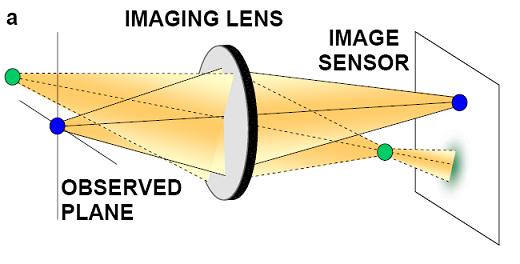Researchers at Ben Gurion University of the Negev and Johns Hopkins University in the US have developed a method that allows holograms to be photographed in normal light or with a fluorescence microscope
By Yael Laban

Holograms - XNUMXD photography - have always been a favorite subject of science fiction writers. The Madev books are full of moving and talking XNUMXD characters that look just like real people. But holographic photography, especially in the field of microscopy, also has an important role in scientific research, as researchers often need accurate information about the spatial structure of cells and organisms.
Humans see three-dimensional vision thanks to the fact that they have two eyes, located at some distance from each other. The brain simultaneously receives two slightly different images and processes them into one three-dimensional image. In holographic photography, the three-dimensional image is recorded by using two light beams (a beam reflected from the imaged object and a reference beam) that interfere with each other to create a single pattern. The interference pattern preserves not only the intensity of the light (as in normal photography) but also its occurrence (phase) which allows the distance from the camera of each point on the object to be recorded on the photographic film. The most common technique for creating holograms is the Fresnel hologram: each point on the object becomes a set of rings with a common center (Fresnel pattern) and the density of the rings represents the distance of the point from the photographic film. In the conventional method for holographic photography, laser beams must be used. The uniqueness of the laser is that it is coherent, meaning that it has a unique wavelength and incidence that are known in advance. In holographic photography, therefore, two rays compete with each other: the reference beam that comes straight from the laser device to the photographic film and the object beam that leaves the laser device and is reflected from the imaged object.
Professor Yossi Rosen from the Department of Electrical and Computer Engineering at Ben-Gurion University of the Negev, together with Professor Gary Brooker from the Center for Microscopy at Johns Hopkins University in Maryland in the USA, discovered a way to photograph holograms in white light using a simple and extremely fast system. "White" light is not coherent light, meaning it contains a wide range of wavelengths with different occurrences. To overcome this problem, Rosen and Brooker used a device called a Spatial Light Modulator (SLM), which changes the spatial shape of the wavefront. Rosen and Brooker introduced two different diffraction gratings on the SLM and through them they passed the light beam, which is now able to interfere with itself. When the subject of the photograph is illuminated with white light, each point on its surface reflects one specific wavefront, meaning that the light from one point is coherent to itself. When the reflected light is passed through the SLM, it splits through the two different diffraction gratings into two mutually coherent wavefronts, since they emerge from the same point. Therefore, the two fronts can interfere with each other and create a Fresnel pattern. The camera collects and connects the interference patterns from all the points that make up the bone and creates, with the help of computer processing, the hologram.
The need for a computer is due to the fact that the resulting hologram is on-axis ("on one axis"): since the light is reflected from one point, there is no angle between the two rays as in off-axis methods (where there is an angle between the reflected light and the reference beam). On-axis holograms create a "twin figure" problem - duplication that must be eliminated. This is done by using three pairs of knits (actually, three different combinations of two knits each time) and computerized processing.
The proposed method, given the name FINCH (Fresnel INcoherent Correlation Holography) has several advantages: it is possible to photograph holograms in natural light, including sunlight or the light of common thermal lamps ("rainbow lamps"); The method uses one relatively simple optical system, which makes it very resistant to vibrations and distortions (unlike other systems); The system may be relatively small so that it can be carried outside the house; And the photography is very fast - which may make it possible to shoot holographic films in the near future.
Another important advantage is the possibility of photographing holograms through a fluorescence microscope. Fluorescent radiation is incoherent light, so until now it was not possible to use it to photograph holograms. With the help of Rosen and Brooker's FINCHSCOPE, it is possible to create a XNUMXD and color visualization of cells and bacteria while combining the FINCH method and a fluorescence microscope.
The FINCH method is currently in the development stages: a first prototype is already working and the researchers hope to soon make the method available to scientists in the various fields of the natural sciences - and in the future, perhaps also to gadget and science fiction enthusiasts.

One response
The article looks very interesting. It's just a shame that there isn't that much connection between the illustration and what is explained in the text.